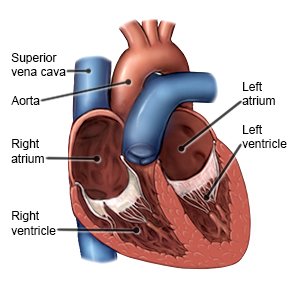Pericardial Effusion
Medically reviewed by Drugs.com. Last updated on Aug 4, 2025.
AMBULATORY CARE:
Pericardial effusion
is a buildup of fluid in the pericardium. The pericardium is a 2-layer sac that surrounds the heart. The sac normally contains a small amount of clear fluid between its layers. This allows the heart to move smoothly against other organs in the chest as it beats. The fluid buildup puts pressure on your heart. This makes it difficult for your heart to pump. Fluid may collect slowly or quickly.
 |
Common signs and symptoms of pericardial effusion:
You may not have any symptoms, or you may have any of the following:
- Chest pain or discomfort that may get better when you sit up
- Cough
- Feeling lightheaded or faint
- Swelling of your legs and feet
- Shortness of breath, especially when lying down
- Trouble swallowing food
Call your local emergency number (911 in the US) if:
- You have any of the following signs of a heart attack:
- Squeezing, pressure, or pain in your chest
- You may also have any of the following:
- Discomfort or pain in your back, neck, jaw, stomach, or arm
- Shortness of breath
- Nausea or vomiting
- Lightheadedness or a sudden cold sweat
- You have sudden chest pain.
- You have sudden trouble breathing.
Related medications
Seek care immediately if:
- You feel lightheaded or faint.
- You have swelling in your legs or feet.
Call your doctor or cardiologist if:
- You have a fever.
- You have questions or concerns about your condition or care.
Treatment
depends on the cause of your pericardial effusion. You may need any of the following:
- Antibiotics help treat an infection caused by bacteria.
- Steroids help decrease swelling.
- NSAIDs help decrease swelling and pain or fever. This medicine is available with or without a doctor's order. NSAIDs can cause stomach bleeding or kidney problems in certain people. If you take blood thinner medicine, always ask your healthcare provider if NSAIDs are safe for you. Always read the medicine label and follow directions.
- Pericardial drainage relieves pressure on your heart so it can pump normally. A catheter is inserted into the pericardium to drain fluid.
- A balloon procedure is another way to drain extra fluid. A needle is put into the pericardium and a guidewire is threaded through the needle. The needle is then removed. A catheter with a balloon at its end is passed over the guidewire into the correct position in the pericardium. The balloon is inflated and deflated several times to create an opening for the fluid to drain out.
- Surgery may be done to remove part or most of the pericardium.
Treatment options
The following list of medications are related to or used in the treatment of this condition.
Follow up with your doctor or cardiologist as directed:
You will need to return for more tests to see if the fluid around your heart has come back. Write down your questions so you remember to ask them during your visits.
© Copyright Merative 2025 Information is for End User's use only and may not be sold, redistributed or otherwise used for commercial purposes.
The above information is an educational aid only. It is not intended as medical advice for individual conditions or treatments. Talk to your doctor, nurse or pharmacist before following any medical regimen to see if it is safe and effective for you.
Learn more about Pericardial Effusion
Treatment options
Care guides
Symptoms and treatments
Further information
Always consult your healthcare provider to ensure the information displayed on this page applies to your personal circumstances.
